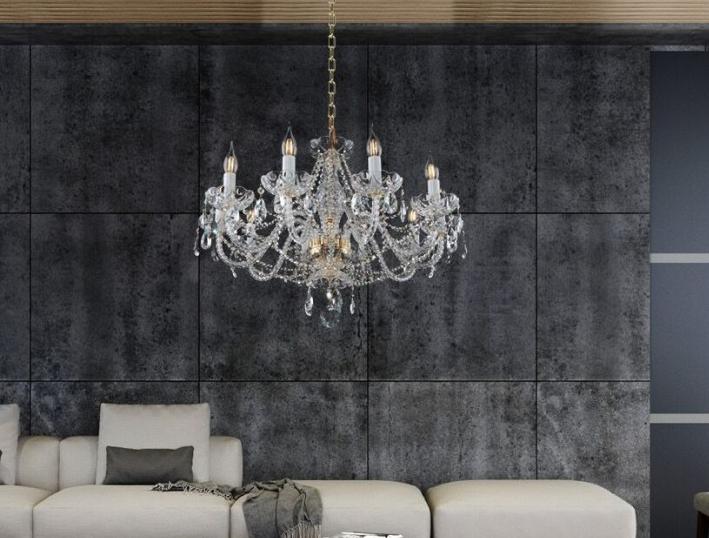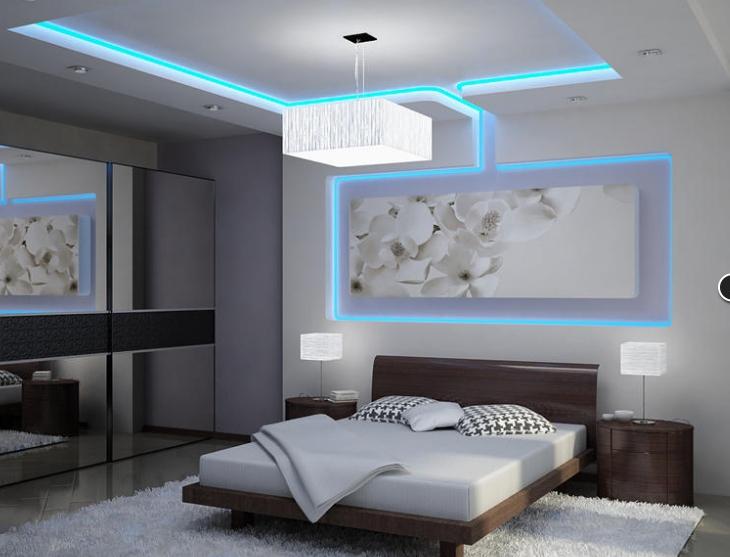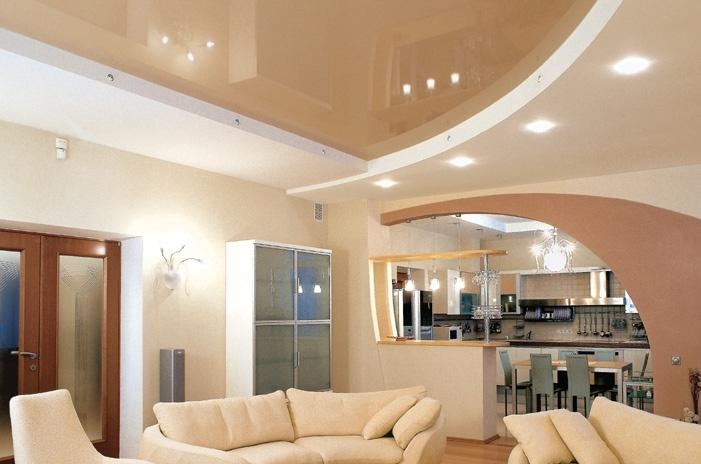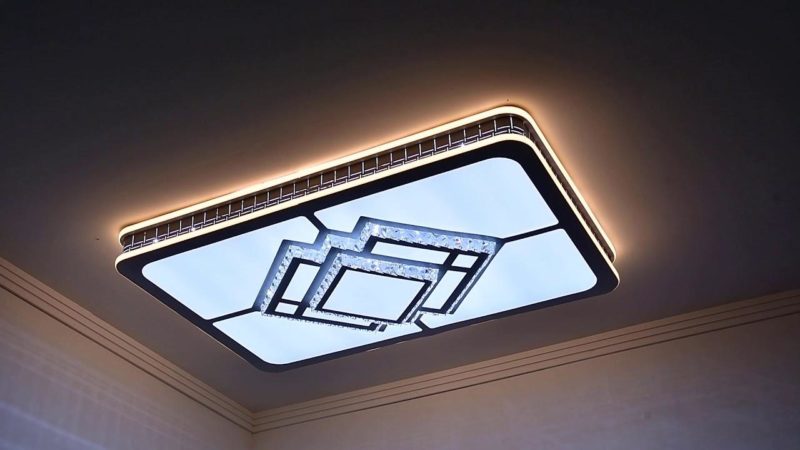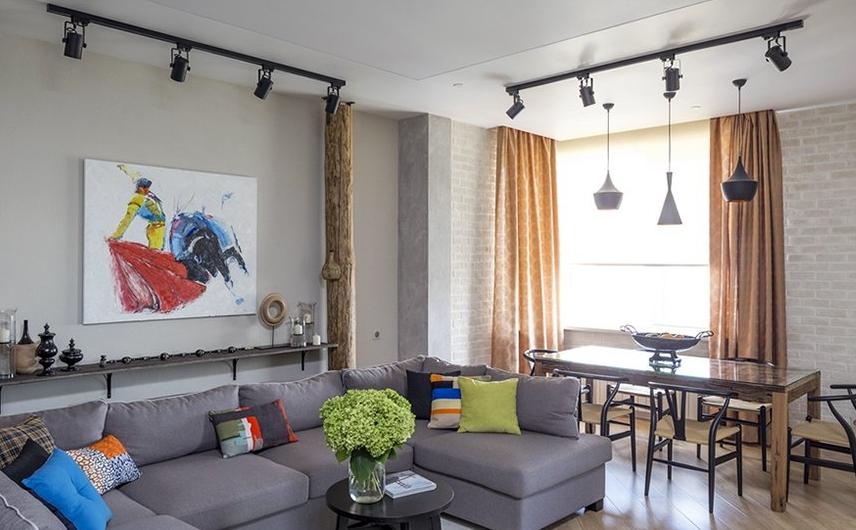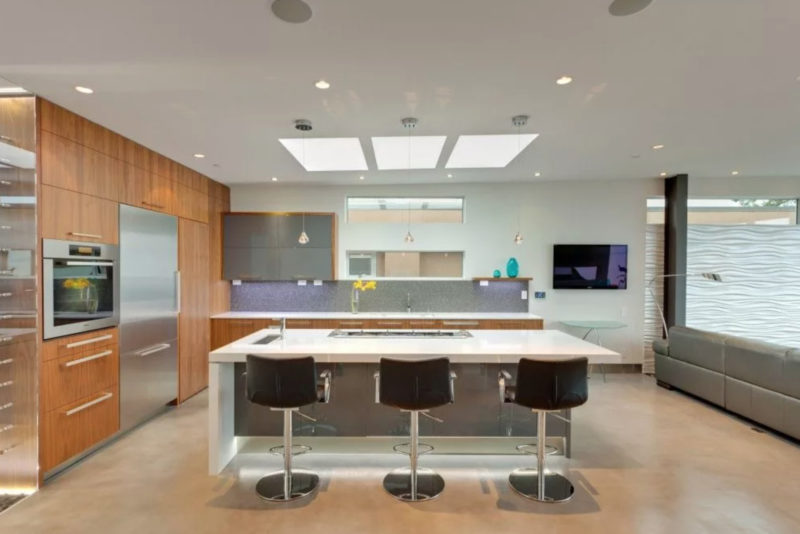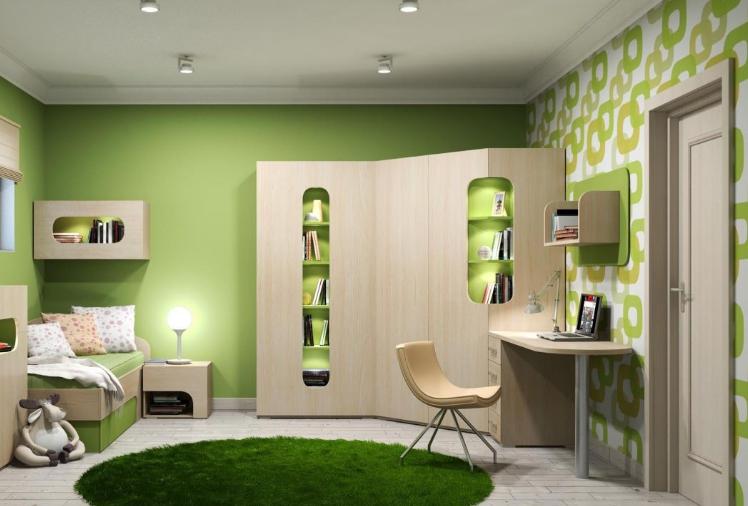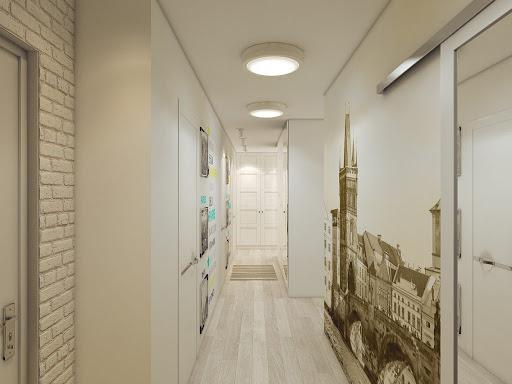Features of ceiling lighting
Ceiling lighting is a basic option for any apartment or house. On the choice of equipment depends on the comfort of staying in the room and the appearance of the room. In addition, it is important to use only safe devices that last a long time and do not require high costs for bulb replacement.
Types of ceiling lights
Variants can be distinguished depending on the type of ceiling. There are basic varieties, which are used as a starting point when describing the types of ceiling lighting. But this does not mean that this or that type of light can be used only in a particular design. It is important to understand the features in order to choose what works best for a particular room.
For wooden and concrete ceilings
Making ceiling lighting on such bases is not difficult, as they are characterized by resistance to stress. But there are a number of restrictions, for example, you can not install recessed lights. In addition, when working with wooden structures, it is necessary to strictly comply with fire safety regulations. The main features are as follows:
- Typically, the main lighting is provided by chandelierwhich is placed in the middle. For rooms with a small area can be sufficient and the lamp with a diffusing plafond. For mounting, you use hooks or brackets, which are often included.The more light bulbs, the larger the area can illuminate the chandelier.
- If you need additional lighting, put overhead fixtures or track systems of suitable length. There are many varieties, you should pick up under the style of decoration of the room and the requirements for lighting. The main thing is to bring the wiring in advance.Track lighting system with open wiring on the concrete ceiling.
- To create contour lighting using LED strip ceiling skirting board. It is easiest to fix it with an indentation from the surface to put the strip in the resulting cavity. Due to this, the light will be uniform around the perimeter.The contour can go from the ceiling to the walls, creating an interesting effect.
You can buy an aluminum baseboard with a recess for the LED strip and a scattering plug. This option will suit modern interiors well.
For stretch ceilings
Stretch fabric is not only a convenient option for a quick transformation of the room. On it you can use different types of ceiling lighting. Usually apply the following solutions:
- The main source of light is located in the middle. If the room is elongated, there can be several to provide normal lighting. There are no special restrictions here, the main thing is to prepare in advance the place of installation: to fix the bracket and bring the wire, as after the stretching of the ceiling it will not be possible to do so.The lamp in the center of a small kitchen.
- Additional lighting can be almost anything. The cavity under the canvas allows you to put recessed equipment, the main thing is that it is suitable in size. For normal installation, the ceiling is pre-glued with rings of suitable diameter, and then cut a hole inside.Lights can also be placed on the sides of the stretch ceiling.
- It is possible to achieve effects that are impossible on other types of ceilings. For example, with the help of special pins to create a starry sky or make the entire surface luminous. This is realized by attaching light sources above the ceiling and stretching a translucent light-diffusing fabric.With the help of special pins you can create the illusion of a starry sky.
On stretch ceilings, it's especially important to make an exact design in advance and mark locations of all light sources in order to arrange the wiring.
For two-level and multi-level constructions

When selecting lighting for such systems, a few simple recommendations are followed. The main thing is to take into account the peculiarities of design and size of the room. Remember the following:
- To highlight the protruding elements use lighting around the perimeter, hidden in the niche. As a result, you get the effect of "soaring ceiling", which gives the environment originality.
- If the ledge in the middle, it is worth choosing a compact main source of light so it does not hang too much. With a high ceiling height there are no restrictions, the main thing - so that the light sources do not interfere with the movement.
- For ledges on the sides are great built-in lights. Their number and location depends on the configuration of the design and zoning of the room.
For drywall ceilings
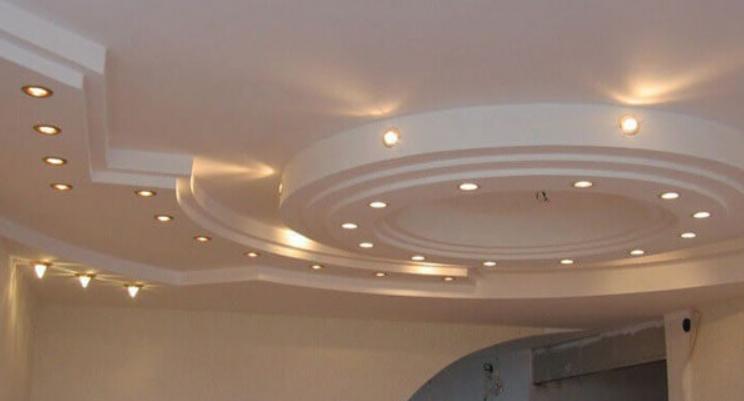
This option is popular, with its help it is possible to implement almost any projects. In this case, the choice of lighting for plasterboard ceilings has peculiarities:
- When installing heavy elements for the main light, the place of their attachment is reinforced before the plasterboard paneling of the surface. This will eliminate any problems and simplify the work. The size and configuration of the lights are chosen to suit the room, there are no restrictions.
- The material allows you to put recessed equipment, which is convenient for additional lighting. Its size is selected for the space above the ceiling.
- If it is necessary to install lighting, a niche is made for it. Its size depends on the effect that you want to get as a result.
On plasterboard and stretch ceilings often use a special profile, of which you can make light figures or broken lines.
Types of lights for ceiling illumination
There are many options, but all of them can be divided into several main groups according to the peculiarities of design. When choosing, proceed from the characteristics of the room and the characteristics of the equipment:
- Chandeliers. The main source of light, most often installed in the middle. In a long room you can hang 2 or more.Two chandeliers in the living room is a modern solution that looks original.
- Recessed lighting fixtures (spotlights). Suitable for hollow structures, can be standard or adjustable.Spot lights in combination with a light niche look stylish.
- Surface-mounted models. Used on those bases where there are no voids.Overhead lights come in different sizes and shapes. Lamps and light-emitting diodes are used as an element of light.
- Track systems. Due to the rail, it is possible to put plafonds in any place, which is very convenient.The track systems are a convenient and practical solution.
- Light modules. Include from two spotlights and provide good light in a small area.
- LED panels. Can serve as a substitute for a chandelier.Example of lighting the dining area with light panels.
- LED strip Most often used for backlighting. But if you glue a few rows, the intensity of light will be sufficient for the main lighting.LED strip allows you to implement projects of any complexity.
Calculating the number of lights
To determine the number of fixtures, you need to consider the type of room and standard of light for it. All figures are prescribed in SNiP, for convenience are collected in a list:
- Living rooms and kitchens - from 150 Lm per meter.
- Children's rooms - from 200 lumens.
- Bathrooms, toilets, showers and corridors - from 50 Lm.
- Checkrooms - from 75 Lumen.
- Workrooms and libraries - from 300 Lumens.
These are minimum standards, most often the level of illumination is higher. To regulate the intensity of light, you use several modes on the switch or dimmer to regulate brightness.
The choice of ceiling lighting for different rooms in the apartment
Depending on the characteristics of the room, different types of equipment are used. It is important to position it correctly in order to qualitatively illuminate individual zones and ensure an even distribution of light across the room. To do it right, you need to remember the simple recommendations:
- Bedroom. In this room, you should create a calm environment that promotes relaxation and rest. Therefore, when choosing light sources, preference is given to yellowish options. The main light should have several modes of operation. Also often installed decorative lighting, it can be as spot built-in lights, and LED strip lights. It is possible to allocate separate zones if necessary - the space in front of the mirror or the working area, if there is one.Starry sky effect in the stretch ceiling of the bedroom.
- Living room. This room should be illuminated qualitatively and provide for all the nuances of use. The main attention is paid to the guest area, the table should be illuminated qualitatively, for this purpose any suitable equipment is used. Also decorative lighting is often used to decorate the interior and emphasize the unusual design of the ceiling. If the living room has zones - for recreation, games, crafts, etc., the light for them is selected individually. It is desirable that it is switched on separately from the main one.Modern living rooms can be illuminated in a very original way.
- Children's room. In this room, it is important to create a comfortable environment for vision, so that children do not tire their eyes. To do this, selected light sources only with a natural spectrum, close to the daytime. It is necessary to allocate functional areas - a play area and for preparing lessons, for this purpose additional equipment is used. LED lighting will be appropriate, which serves not only as a decoration, but also as a night light during sleep.In the children's room, you need to create the perfect environment so that the child's vision is not strained.
- Kitchen. If the room is small, you can provide normal lighting at the expense of a single chandelier, located exactly in the middle of the free space. Well better to use additional light for the work surface and the dining area. There are many options, you can use both conventional spotlights and adjustable models.For the kitchen, light lines are excellent and can replace the traditional chandelier.
- Bathroom и WC. Here you can provide a normal intensity of light through spotlights. The number and location are chosen depending on the area and shape of the room. It is important to consider the color and reflectivity of surfaces, this determines the choice of power equipment.Built-in module in the bathroom gives enough light.
- Hallway or hallway. In apartments, most often these rooms are small in size. Therefore, two or even one row of spotlights is enough for normal lighting. If the space is square, the light sources should be arranged differently, so that they are distributed evenly across the ceiling. It is worth paying attention to the space in front of the mirror.If the corridor is long, you can install several lights linearly, along the entire length of the ceiling.
Recommended to watch: The secret of perfect lighting in the apartment.
Choosing ceiling lighting for the apartment is not difficult. The main thing is to take into account the features of the room, the design of the ceiling and its size. You can implement different options, it is best to use several modes of lighting in living rooms.
